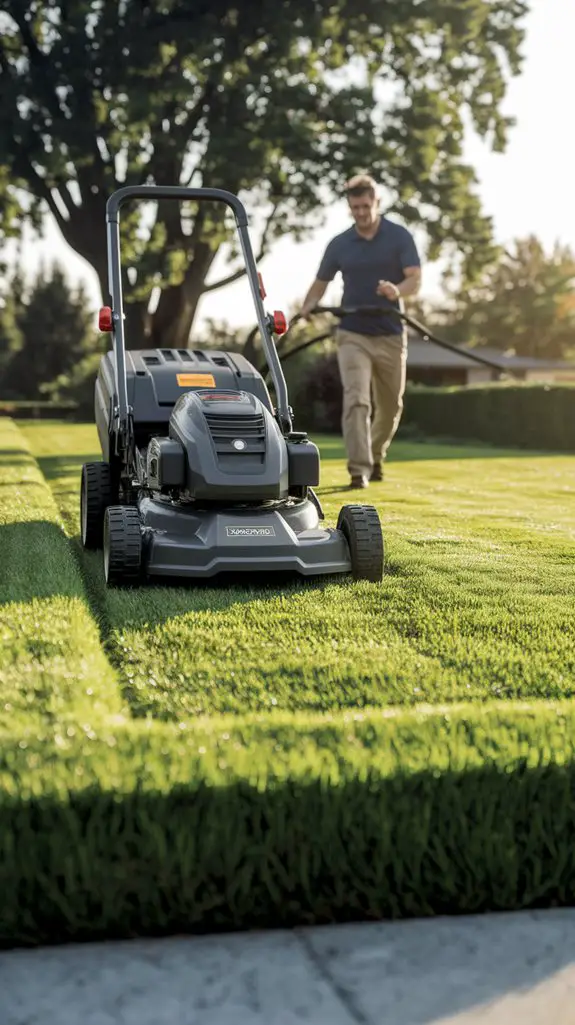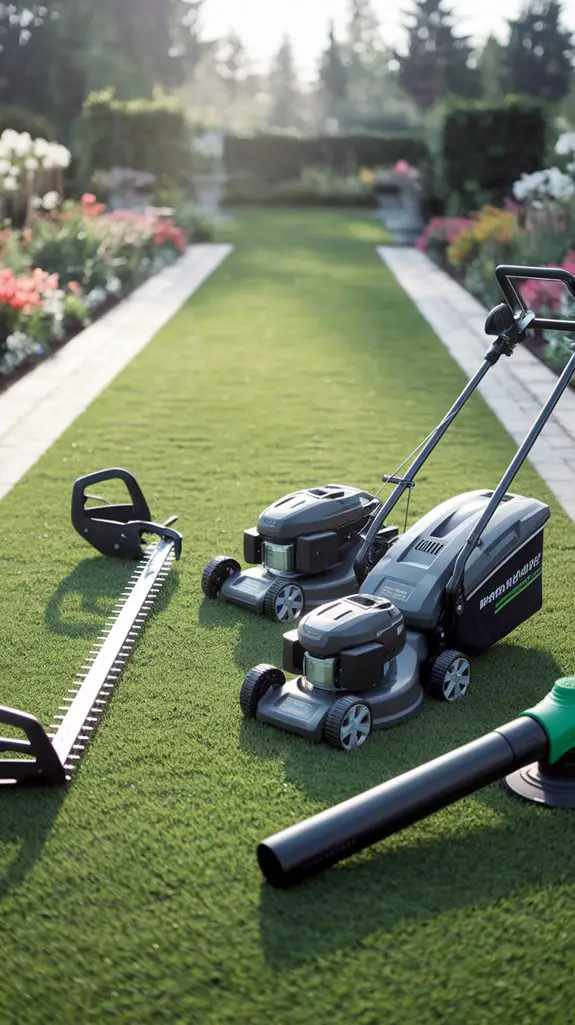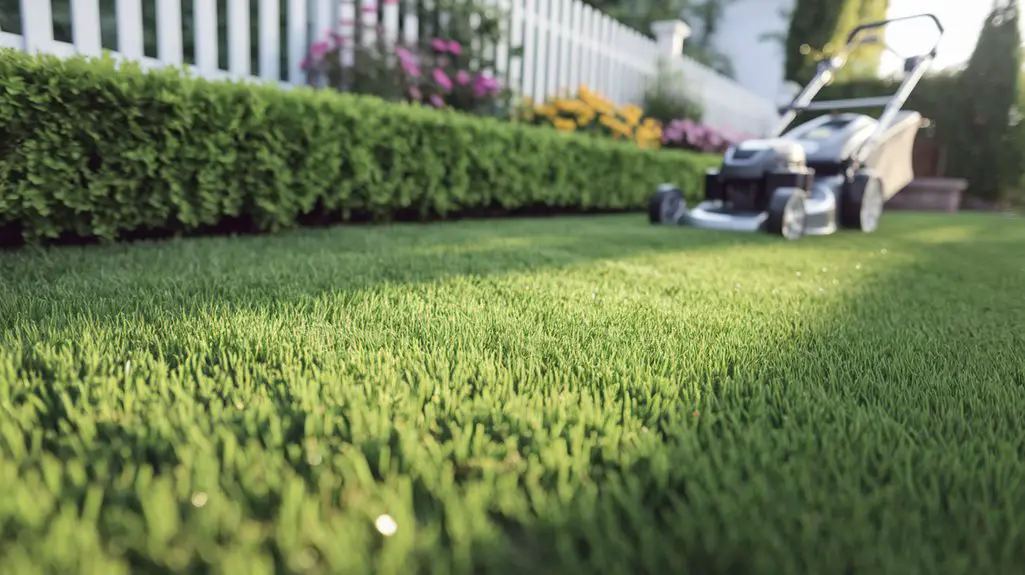You’re facing a common dilemma: wanting a beautiful lawn without sacrificing your precious weekend hours. Smart lawn care isn’t about working harder—it’s about strategic maintenance. By focusing on proper mowing height, efficient watering techniques, and selecting appropriate grass varieties, you’ll maximize results while minimizing effort. The science behind sustainable lawn care reveals that small, consistent interventions yield better outcomes than sporadic intensive maintenance. Let’s examine how these principles translate into practical time-saving solutions.
Quick Weekend Maintenance Plan
When properly scheduled, lawn maintenance need not consume your entire weekend. Allocate 2-3 hours on Saturday mornings for essential tasks based on seasonal requirements.
During spring, focus on dethatching and fertilizing with nitrogen-rich compounds (20-5-10 NPK ratio). Additionally, ensuring healthy soil promotes better nutrient absorption and overall lawn vitality.
Summer demands strategic irrigation—0.5 inches twice weekly rather than daily shallow watering that promotes shallow root development.
In autumn, implement core aeration to mitigate soil compaction and improve oxygen penetration to the root zone.
Mow consistently at the proper height for your grass variety: 2.5-3 inches for cool-season species (Kentucky bluegrass, fescue) and 1-2 inches for warm-season varieties (Bermuda, Zoysia).
Always follow the one-third rule—never remove more than one-third of blade height during a single mowing session.
Time-Saving Mowing Techniques

Efficient mowing patterns greatly reduce lawn maintenance time while promoting ideal turfgrass health. Implementing systematic approaches minimizes overlap while ensuring complete coverage of your turf area.
Utilize these scientifically-validated techniques to enhance mowing efficiency:
- Employ perimeter-inward spiraling patterns to eliminate time-consuming turns, reducing compaction while maintaining consistent clipping distribution across the lawn’s surface.
- Maintain ideal blade height (7-9 cm for cool-season grasses, 5-7 cm for warm-season varieties) to minimize mowing frequency while enhancing photosynthetic capacity and root development.
- Implement the one-third rule—never remove more than 33% of leaf tissue during a single mowing event, which reduces physiological stress and decreases clipping volume requiring management.
For large properties, sectional mowing allows turfgrass recovery between maintenance intervals, enhancing overall lawn resilience. Additionally, consistent mowing schedules can significantly improve the overall appearance and health of your lawn.
Essential Lawn Tools for Efficiency

The six fundamental tools required for efficient lawn maintenance encompass both mechanical and manual implements strategically selected to minimize labor while maximizing turfgrass health outcomes.
A precision-calibrated broadcast spreader guarantees uniform distribution of fertilizer and soil amendments, while a battery-powered sprayer facilitates targeted application of herbicides and fungicides.
Invest in an electric or cordless trimmer with adjustable cutting height for managing vegetation at lawn perimeters and around obstacles. A high-quality mulching mower promotes nitrogen cycling via decomposition of grass clippings in situ.
For soil aeration, consider a manual core aerator for small lawns or a mechanized unit for larger areas.
Finally, acquire a soil testing kit to monitor pH and nutrient levels, enabling data-driven decisions regarding amendment applications and preventing unnecessary resource expenditure. Additionally, maintaining healthy grass is essential for creating lush backyard pathways that enhance the overall landscape.
Low-Maintenance Grass Varieties
Selecting appropriate grass varieties represents the cornerstone of sustainable lawn care for time-constrained homeowners. Your climatic zone determines ideal species selection, with warm-season and cool-season grasses requiring different maintenance protocols.
Zoysia, Buffalo, and Fine Fescue cultivars exhibit superior drought tolerance and reduced mowing requirements.
- Zoysia japonica – Establishes dense thatch with exceptional heat resistance, requiring 30% less irrigation than traditional Kentucky bluegrass. Thrives in USDA zones 6-9.
- Buffalo grass (Buchloe dactyloides) – Native prairie species with extensive root systems reaching 12+ inches, enabling survival during extended drought periods.
- Fine Fescue blends – Combines Chewings, Hard, and Creeping Red Fescue varieties that flourish in partial shade with minimal nitrogen inputs and considerably reduced mowing frequency.
Smart Watering Systems and Schedules
Water management represents the critical determinant of sustainable lawn health while minimizing resource expenditure for today’s time-pressed property owners.
Implementing automated irrigation systems with soil moisture sensors optimizes hydration delivery based on actual lawn requirements rather than predetermined schedules.
You’ll achieve maximum efficiency by watering during pre-dawn hours (4-6am) when evaporation rates remain minimal and wind disturbance is reduced.
Program your system to deliver 1-1.5 inches weekly, preferably in two deep-watering sessions rather than frequent shallow applications that promote shallow root development.
Consider installing smart controllers that integrate local weather data, automatically adjusting watering schedules during precipitation events.
These systems reduce water consumption by 20-50% compared to conventional timers while maintaining turfgrass vigor through precise hydrological regulation that respects both soil infiltration rates and plant transpiration needs. Additionally, the right watering schedule can significantly enhance the quality and vibrancy of seasonal blooms.
Seasonal Care Calendar for Year-Round Results
Beyond irrigation management, successful lawn maintenance requires systematic timing of horticultural interventions throughout the calendar year. Your turfgrass exhibits distinct physiological responses to seasonal variations in temperature, precipitation, and photoperiod length.
- Early Spring (40-55°F soil temperatures) – Apply pre-emergent herbicides to inhibit crabgrass germination; core aerate cool-season grasses; test soil pH and amend accordingly with lime or sulfur.
- Summer (June-August) – Raise mowing height 0.5-1 inch; apply slow-release nitrogen at reduced rates (0.5 lbs/1000 sq ft); monitor for chinch bugs and sod webworms during drought periods.
- Fall (September-November) – Apply primary nitrogen fertilization (1 lb/1000 sq ft); overseed thin areas while soil temperatures remain above 50°F; remove leaf debris to prevent fungal pathogens. Additionally, maintaining healthy soil can significantly enhance vegetable garden growth by providing essential nutrients for plants.
Natural Shortcuts to Weed Control
While chemical herbicides present expedient solutions for weed suppression, ecologically conscious alternatives can minimize environmental impact while effectively managing unwanted vegetation in your turfgrass ecosystem. These biocompatible methods leverage natural competitive advantages inherent in healthy lawns. Additionally, incorporating natural pest control methods can further enhance the resilience of your garden against unwanted intruders.
| Method | Application | Timing | Efficacy |
|---|---|---|---|
| Corn gluten meal | 20 lbs/1000 sq ft | Early spring | 60-80% pre-emergent |
| Boiling water | Direct application | Upon detection | 90% for taproot species |
| Vinegar solution (30%) | Spot treatment | Sunny days | 85% for broadleaf weeds |
| Competitive overseeding | 3-4 lbs/1000 sq ft | Fall | 70% reduction annually |
You’ll achieve peak results by integrating these approaches with proper mowing heights (3-4 inches) and irrigation practices. This multifaceted strategy promotes robust turfgrass density that naturally outcompetes weed intrusion through resource competition.
Lawn Care Automation Solutions
When homeowners leverage technological innovation for turfgrass management, they can simultaneously reduce physical labor requirements while enhancing resource allocation.
Smart irrigation systems equipped with soil moisture sensors eliminate inefficient watering schedules by delivering precise hydration based on actual lawn needs rather than arbitrary timing.
- GPS-guided robotic mowers navigate property boundaries while maintaining ideal cutting heights of 3-4 inches for cool-season grasses and 1-3 inches for warm-season varieties.
- Automated fertilizer injection systems that integrate with irrigation infrastructure to deliver micronutrients during periods of active root uptake.
- Smart soil monitors providing real-time data on pH levels, nitrogen content, and microbial activity via smartphone applications.
In shaded areas, specific grass types thrive better, allowing homeowners to choose the right varieties for optimal growth in low light conditions.
You’ll maximize photosynthetic efficiency while reducing manual intervention through these automation solutions, effectively converting your conventional lawn into a self-regulating ecosystem.
Delegating Lawn Tasks: When to Hire Help
How effectively should homeowners diagnose the threshold at which professional lawn care services become a scientifically ideal solution? Evaluate your lawn management capacity against horticultural requirements. Professional intervention becomes necessary when fungal pathogens, compaction issues, or nutrient deficiencies exceed DIY remediation capabilities.
| Task Complexity | Time Investment | Professional Recommendation |
|---|---|---|
| Routine mowing | 1-2 hrs/week | DIY for lawns <5,000 sq.ft |
| Fertilization | 3-4 hrs/quarter | Hire for precise NPK application |
| Aeration | 3-5 hrs/biannual | Hire for clay soils |
| Disease treatment | 2-6 hrs/occurrence | Hire for pathogen identification |
| Irrigation setup | 8-12 hrs/install | Hire for ideal hydraulic design |
Quantify your opportunity cost: when task complexity multiplied by hourly value exceeds service cost, delegation becomes objectively rational. Professionals offer equipment accessibility and specialized knowledge of turfgrass physiology that typically surpasses residential capabilities.
Conclusion
Implementing these scientifically-validated lawn care strategies will dramatically enhance your turf’s physiological resilience. You’ll hit the nail on the head by focusing on proper mowing heights, efficient irrigation protocols, and selecting genetically appropriate grass varieties. Your time investment decreases while photosynthetic productivity increases. Leverage automation technologies and schedule seasonal maintenance according to your lawn’s biological requirements. These evidence-based techniques guarantee peak cellular health and root development without demanding excessive temporal resources.




